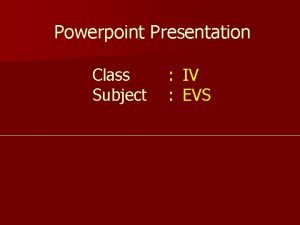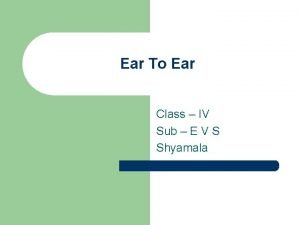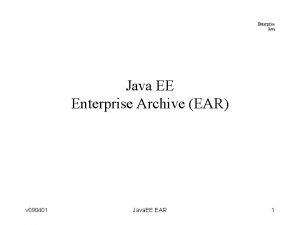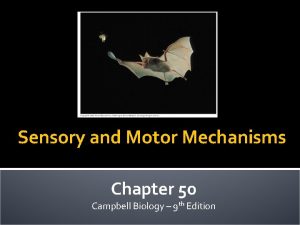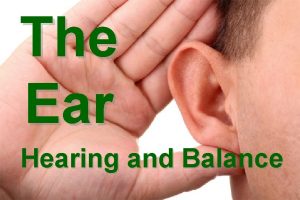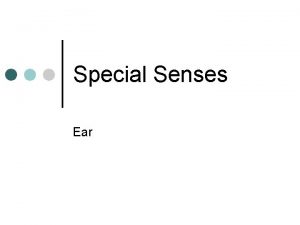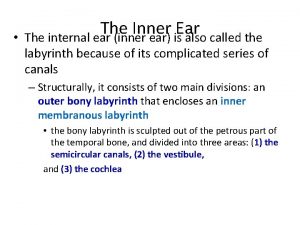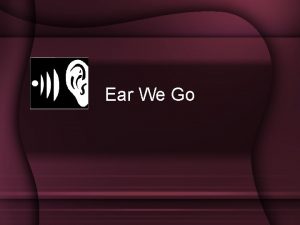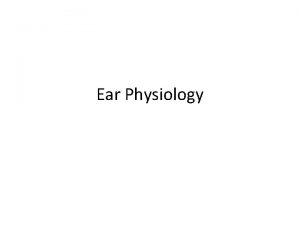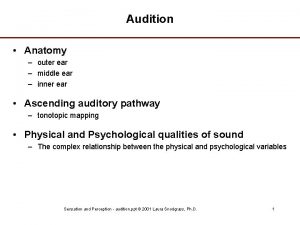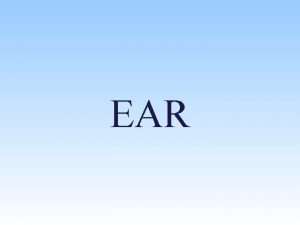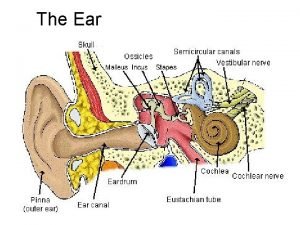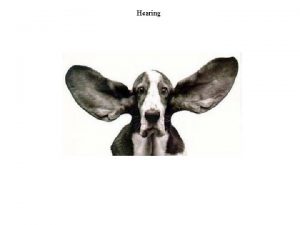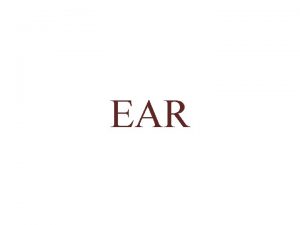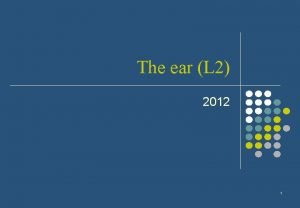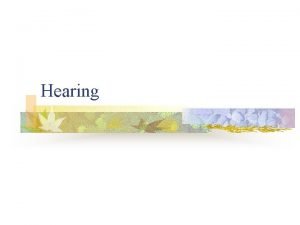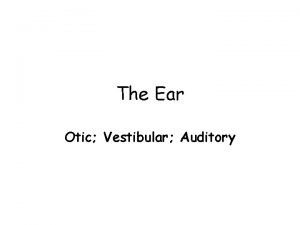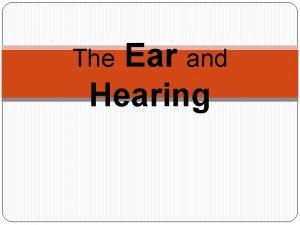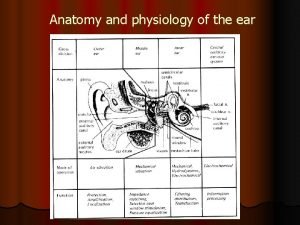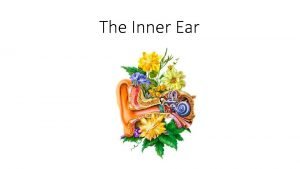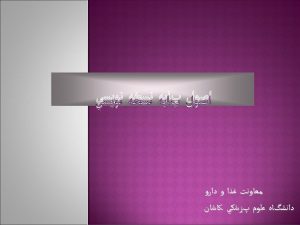The ear STRUCTURE OF THE EAR 2 THREE
























- Slides: 24

The ear

STRUCTURE OF THE EAR 2

THREE PARTS OF THE EAR The ear consists of three regions: • Outer ear • Middle ear • Inner ear 3

Outer ear • • Pinna External auditory canal Tympanic membrane – Transfers sound waves to the bones of the middle ear Cerumen glands – Specialized wax glands – trap tiny bits of dirt or other tiny foreign materials and move this debris outward, away from the eardrum – Lubricates the skin of the ear canal and tympanic membrane 4

• The area of the tympanic membrane is much larger than the area of the stapes footplate/oval window • Therefore sound is amplified 20 X in the middle ear Middle ear and amplification of sound 5

Inner ear 6

Activity – Provide labels 7

Answer 8

U PATH OF SOUND THROUGH THE EAR • • • Pinna Auditory canal Tympanum Hammer Anvil Stirrup Oval window Cochlea Organ of Corti Auditory nerve 9

PATH OF SOUND 10

Click to edit Master title style Hearing � The stirrup causes the membrane of the oval window to vibrate. � This sets up waves in the perilymph of vestibular canal. � The organ of Corti in the cochlea canal becomes stimulated. � The stimulus is converted to a nerve impulse. � The nerve impulse is carried by the auditory nerve to the cerebrum where the sound is interpreted. 11

Dynamic balance 12

Balance and equilibrium • Sudden changes in speed and direction causes the endolymph within the semicircular canals to move. • The movement of the fluid stimulates the cristae in the ampullae – situated at the base of the semi circular canal. 13

Balance and equilibrium • When the direction of the head changes, gravitational pull stimulates maculae – in the sacculus and utriculus • Within the cristae and maculae the stimuli is converted to impulses • These impulses are sent to the brain by the vestibular branch of the auditory nerve to the cerebellum for interpretation to restore balance. 14

Diseases and disorders of the ear �Middle ear infections are the most common causes of ear ache. �Micro-organisms cause the production of fluids in the middle ear, • Grommets -tiny plastic buttons with a fine hole down the middle may be inserted into the eardrum to allow drainage of the middle ear until the eustachian tube recovers. � the fluid cannot then drain through the eustachian tube as it is swollen, � The fluid caused by the infection makes the Eustachian tube to be swollen, inflamed and clogged. � the accumulation of the fluids increases pressure in the middle ear causing the ear to ache. 15

Deafness and difficulty in hearing • Causes • Damage to hair cells in the cochlea • Due to disease, ageing or injury • Injury to parts of the ear, nerves or parts of brain responsible for hearing • Hardened wax • Hardening of ear tissues such as ossicles • Treatment • Hearing aids • Cochlea implants 16

Cochlea implant 17

Activity 1. 1. Identify: (a) B (b) D 1. 2 Describe the role of the semi-circular canals in maintaining balance. 1. 3 Describe how an increased production of mucus in the nose and throat may lead to the bursting of part E. 1. 4 Explain why fusion of the structures at A may lead to hearing loss. 1. 5 Which part of the brain will receive impulses from part C? 18

QUESTION 2: (Taken from DBE Feb/March 2016) The diagram represents a part of a human ear. 2. 1 Identify part: a) A b) D 2. 2 Name the receptors that are found in part B. 2. 3 Explain the consequence to the human body if: a) Part C is damaged b) Part A becomes hardened 2. 4 Explain why people with middle-ear infections are usually advised not to travel by aeroplane. QUESTION 3: (Taken from DBE Nov 2015 P 1) Describe how the sacculus and utriculus in the human ear maintain balance in the human body. 19

Answers Question 1 1. 1. (a) Auditory nerve √ (b) Round window √ 1. 2. - The cristae √ in the semi-circular canals - are stimulated by changes in speed and direction √ of movement - The cristae convert the stimuli to nerve impulses √ - The nerve impulses are transported along the auditory nerve √ - to the cerebellum √ to be interpreted 20

1. 3. - The mucus will block the opening of the Eustachian tube √ - Air cannot enter or leave the middle ear √ - to equalise pressure √ /causing imbalance in pressure OR - Mucus may move through the Eustachian tube to the middle ear √ - Build-up of mucus causes pressure in the middle ear √ - pushing on the tympanic membrane √ /part E 21

1. 4. - The ossicles/structures at A will not be able to vibrate √ - and hence no vibrations will be passed to the inner ear√/cochlea will not be stimulated 1. 5. Cerebrum √ QUESTION 2 2. 1. (a) Round window√ (b) Cochlea√ 2. 2 Cristae√ 22

2. 3 (a) - Impulses from the cochlea cannot be transmitted to the brain√ - and therefore hearing will not occur √ (b)- Part A will not be able to vibrate √ - The round window will not absorb the sound waves from the cochlea - and hearing will be affected√ (Any 2) 2. 4. - Mucus in the middle ear√ - will lead to the blockage of the Eustachian tube√ - which will not be able to equalise the pressure √ in the middle ear - resulting in pressure on the tympanic membrane √ - that may cause the tympanic membrane to burst √ - leading to hearing loss √ 23

Question 3 Changes in the direction and speed of movement: - Causes the endolymph in part D √ /semi-circular canals to move - The cristae √ are stimulated - and converts the stimulus into an impulse √ - which is transmitted via the auditory nerve √ - to the cerebellum √ from which impulses are transmitted via motor neurons √ - to the skeletal muscles √ /effector - to restore balance of the body √ 24
 Animals whose ears can be seen
Animals whose ears can be seen Animal with ears like fans
Animal with ears like fans Java ear structure
Java ear structure General and special senses
General and special senses Ear inner structure
Ear inner structure Hát kết hợp bộ gõ cơ thể
Hát kết hợp bộ gõ cơ thể Slidetodoc
Slidetodoc Bổ thể
Bổ thể Tỉ lệ cơ thể trẻ em
Tỉ lệ cơ thể trẻ em Gấu đi như thế nào
Gấu đi như thế nào Tư thế worms-breton
Tư thế worms-breton Chúa sống lại
Chúa sống lại Các môn thể thao bắt đầu bằng tiếng bóng
Các môn thể thao bắt đầu bằng tiếng bóng Thế nào là hệ số cao nhất
Thế nào là hệ số cao nhất Các châu lục và đại dương trên thế giới
Các châu lục và đại dương trên thế giới Công thức tính thế năng
Công thức tính thế năng Trời xanh đây là của chúng ta thể thơ
Trời xanh đây là của chúng ta thể thơ Mật thư anh em như thể tay chân
Mật thư anh em như thể tay chân Phép trừ bù
Phép trừ bù độ dài liên kết
độ dài liên kết Các châu lục và đại dương trên thế giới
Các châu lục và đại dương trên thế giới Thể thơ truyền thống
Thể thơ truyền thống Quá trình desamine hóa có thể tạo ra
Quá trình desamine hóa có thể tạo ra Một số thể thơ truyền thống
Một số thể thơ truyền thống Cái miệng nó xinh thế chỉ nói điều hay thôi
Cái miệng nó xinh thế chỉ nói điều hay thôi
